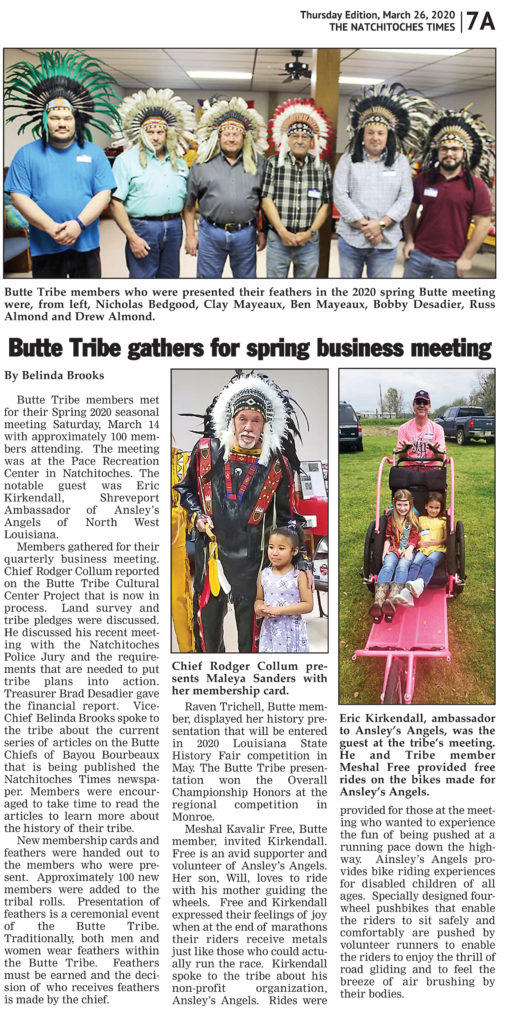
March 26, 2020 – Butte Tribe Gathers for Spring Business Meeting



Written by: Belinda Brooks
Oral History by: Chief Rodger Lee Collum

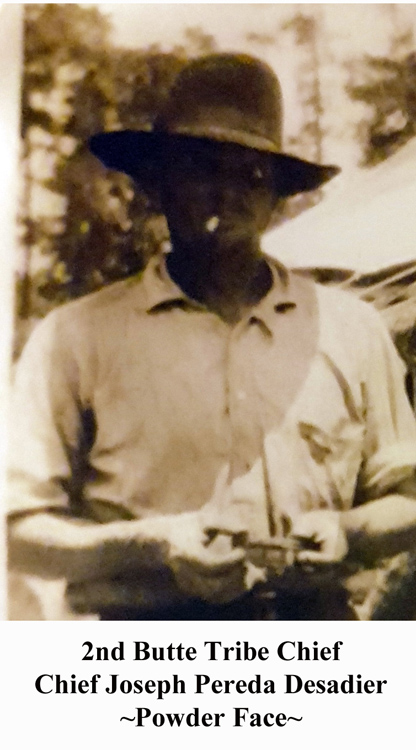
Chief Joseph Pareda Desadier (Joseph Sr.,) 2nd Chief of the Butte Tribe of Bayou Bourbeaux was born February 10, 1798, in the San Fernando Mission at San Antonio, Texas. Listed on the Mission’s baptismal records as his parents were Jose Francisco Pereda and Ana Maria Leal who were both natives of the city. Understanding Catholic baptismal records during the Spanish occupation, one understood that the Spanish’s purpose of converting Native Americans to the Catholic religion was their way of assimilating natives to Spanish culture and claiming their land for Spain. To the ultra-religious Spanish, the indigenous people of America were ignorant heathens who needed salvation.
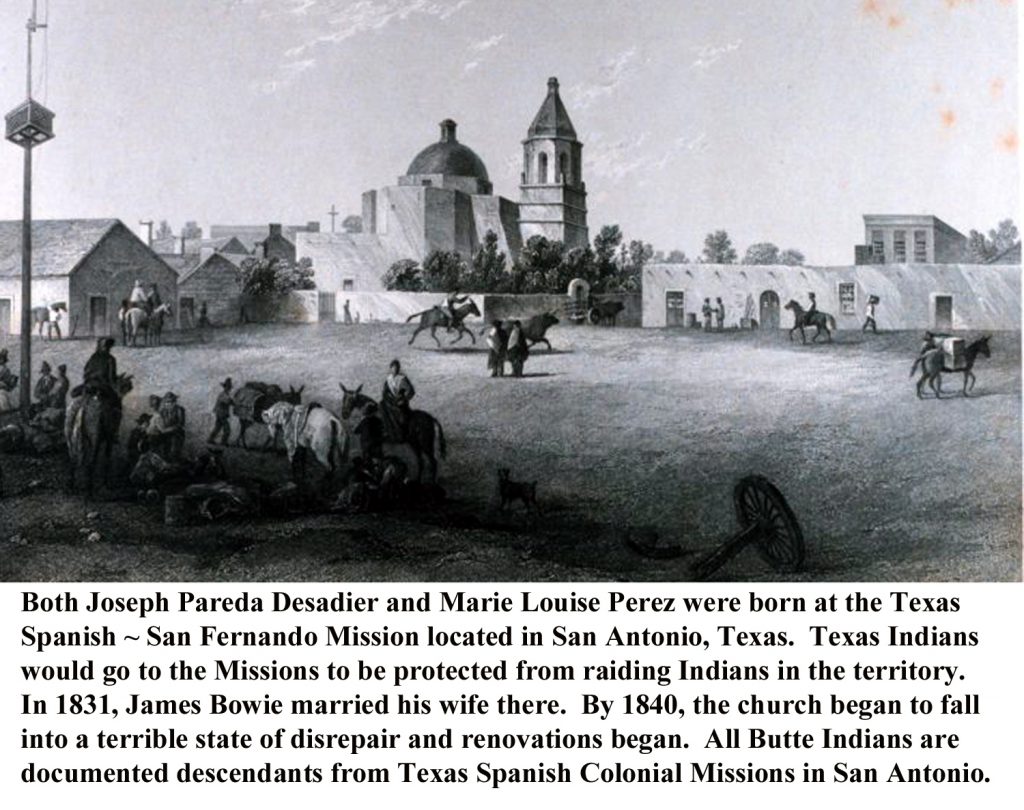
Therefore, Mission Indians were required to be baptized. Upon baptism, the priest would gift each native with a Christian name. That person would then become a Spanish citizen and no longer considered Indian. Christian names given to Joseph’s parents listed above were their baptismal names. Their Native Americans names were White Smoke and Two Moons. The story of their escape from the missions to Bayou Bourbeaux will be revealed in the next and final story of the Chiefs of Bayou Bourbeaux.
As Joseph grew, he earned the native name of Powder Face. When a Butte raiding party would ride out from the village, Joseph’s signature painted face was made with water and white powder. The mixture made a white paint that he used to paint his face solid white. Raiding, killing and torturing their enemies were not given a second thought when it came to protecting their lands and family. Joseph made his first kill at the age of 15. At that time, White Smoke considered his son a man.
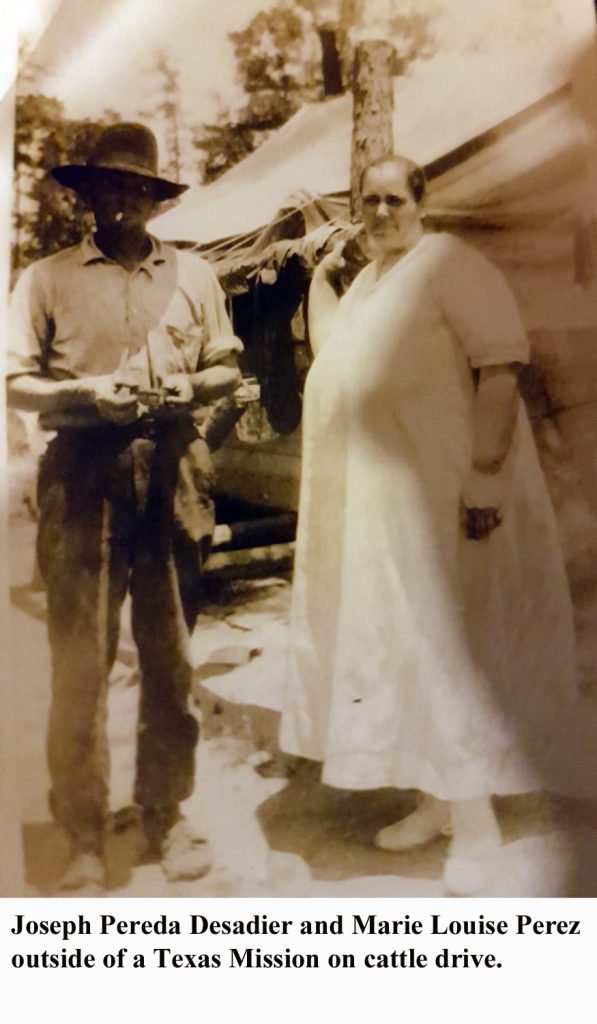
In 1827, Joseph Sr. married Marie Louise Perez. Marie Louise was older than her husband, and like Joseph was born in the San Fernando Mission in San Antonio, Texas. Her family migrated to Louisiana by way of Opelousas, Louisiana. From there, they found their way to Bayou Bourbeaux. She met Joseph there where they raised their family.
TRADE
Trading goods with other tribes and Europeans was a way of life with natives. As a young man, Joseph spent most of his life on the rivers and trails of North America bartering for goods needed by the family. The most popular trade item Buttes had was salt which was gathered from the Goldonna salt licks. Goldonna’s clan was part of the Butte Tribe. Joseph and other young tribal braves would travel the Saline Bayou to Goldonna, back to the Red River; from there, the band of braves would go south to New Orleans, Mexico, South America, or travel north. Butte Tribe traded for items such as bear grease, flint, rock, etc. These trips could last as long as six months or longer. When the braves returned, their first stop would be at the temple mound. There they would leave their best gifts and make their way to the village. The tribe would celebrate by sitting around fires, smoking pipes, telling stories, singing, dancing, and eating specially prepared foods.
PROTECTING BUTTE LAND
Joseph Pareda Desadier was raised on the Louisiana prairie grass and bayou land of Bayou Bourbeaux. His father, Chief White Smoke, moved his people to this land shortly after his birth in 1798. White Smoke controlled all the lands and tribes in the Bayou Bourbeaux area. The prairie grassland was abundant with thousands of buffalos and other wildlife. The buffalo was very important to the survival of the Indians. Native Americans would only kill enough buffalo to supply their needs. Every part of the buffalo would be used and nothing wasted.
Since the Louisiana Purchase in 1803, White Smoke met with the territorial Indian Agent, John Sibley. Sibley’s main job as agent was to prepare area tribes for governmental land survey. Sibley assured White Smoke of the “Great White Father’s,” President Thomas Jefferson’s, promise that Butte tribal land would be held as sacred land and the government would not take one acre of their land without White Smoke’s consent. Having lived and escaped from the Texas Missions, White Smoke had no trust in the words of white men. Joseph was raised with the knowledge of all the things that his people had lived through.
As time passed and the government changed leaders, Andrew Jackson became the 7th President of the United States in 1829. Jackson wasted no time targeting Native Americans. In his 1829 State of the Union Address, Jackson called for removal of Native Americans from the southeast to Texas and Oklahoma territories. By forcibly removing the Native Americans west, the Southern states would gain the ill-gotten land that belonged to the natives. The Indian Removal Act was signed in 1830 and put into action immediately.
Joseph and his father were waiting. European settlers had tried to claim their land many times before. Their plan was put into action. The family would first assimilate to the white man’s ways. Then, they would watch and be ready. Next, everyone knew what shutting down the bayou meant. It had happened before. It would happen again. Beware to settlers who dared to cross Butte land!
CATTLE DRIVES
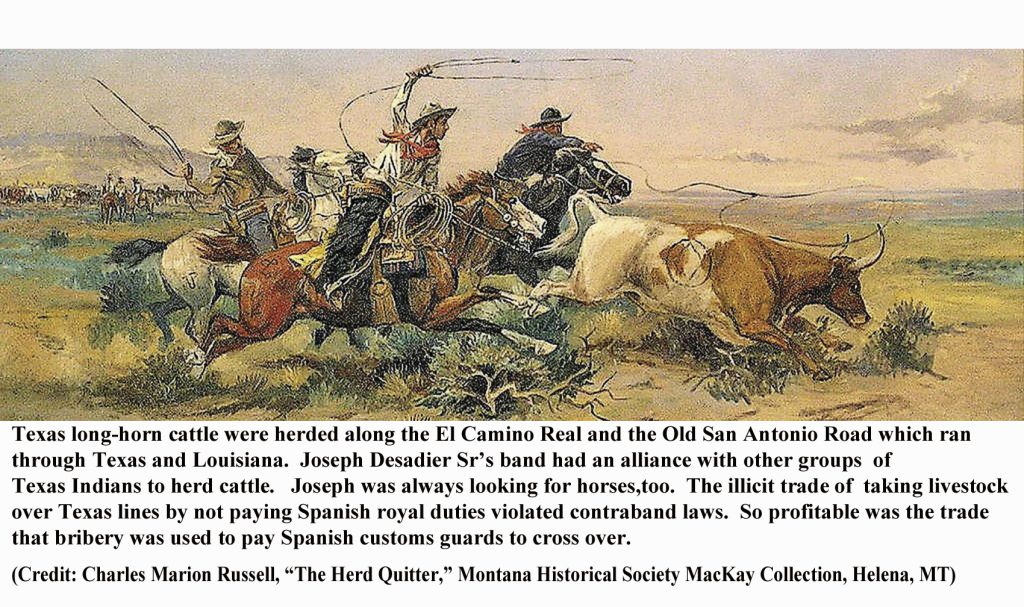
As time passed, white settlers soon found their way to the bayou lands. Oddly enough, there were no white settlers on Butte land. But, the rich land and abundance of wildlife around Natchitoches Parish were too enticing for settlers to resist. They started marking off land near Butte land with no thought of natives who had lived on the land for hundreds of years. Buffalo were being slaughtered. Contention between Native Americans and whites were high. The senseless killing of numerous buffalo for sport by white men left little for the natives’ lifestyle. By the 1830s, there were very few buffalo left on the prairie.
Joseph had to start a new chapter in the lives of his people. Horses and Texas long-horns were where Joseph’s new interests lie. Joseph would travel anywhere to find the fastest, most stunning horses. He was known far and wide for his outstanding walking and quarter horses. Texas long-horn cattle were free-range cattle. They were there for the taking and the market was in high demand. One steer could bring ten times its cost. As a good business man, Joseph couldn’t pass that up. He with his band of men traveled the El Camino Real and Old San Antonio Trail often to return with hundreds of heads of cattle to sell or trade on the open market in New Orleans or at the docks on the Mississippi River.
Joseph ‘s wife, Marie Louise was away from her home one day when she was attacked by a raiding group of Indians led by a warrior named Red Hawk. She took an arrow to her arm, was scalped, and left for dead. Within a short time, Joseph got word of the attack. It only took a few minutes to don his painted face, saddle up his fastest, gather his raiding party and hit the trail heading for St. Maurice.
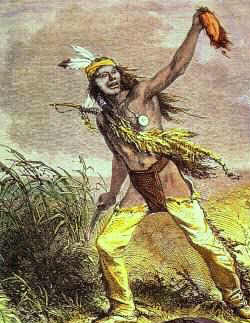
Joseph aka “Powder Face” knew his enemy, Red Hawk, well. Red Hawk and his men were known for stealing livestock and killing settlers in the surrounding area. The attack on Marie Louise may have been by accident with Red Hawk not realizing who he was attacking until the deed was done. Whatever the case, he had Powder Face to deal with now. The two bands clashed on the trail to Winn Parish near St. Maurice. Powder Face, angry and ready to draw blood, rushed in on the offending band of Indians. He only had tunnel vision for Red Hawk. As he drew near to Red Hawk, he leaped from his horse with a sharp war-cry and attacked. Both warriors hit the ground, quickly jumping to their feet, and drawing their knives for hand-to-hand battle. Powder Face drew first blood by slicing Red Hawk across the face. He gave his rival a wicked grin. As was his custom, he backed fair enough away to taunt Red Hawk for his weakness. Red Hawk reached up to touch the deep slash on his face. In anger, he rushed toward Powder Face who stepped aside taunting Red Hawk again with a sparkle in his eyes. As Red Hawk turned around, Powder Face went in for the kill. The battle ended quickly after that with Red Hawk’s bloody scalp dangling from Powder Face’s lance. Powder Face kept the scalp on the end of his spear until the day he died. He was buried standing up with his arms folded around his lance adorned by Red Hawk’s scalp. As for Marie Louise, she recovered from the scalping, but her hand became infected and she eventually lost two fingers.
BUFFALO KILL
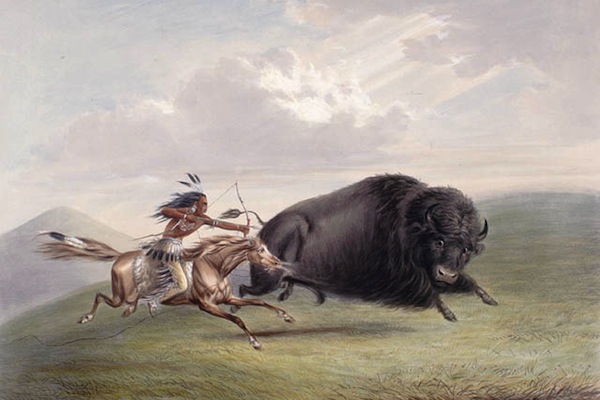
Another story that was told by the elders was about Joseph’s buffalo kill. There were few buffalo on the prairie. Joseph decided that he was in need of a buffalo to feed his family. As there was no refrigeration, the buffalo meat would be shared among the tribe families. The remaining parts of the animal would be used for other essential needs. He rode out to the prairie to find his mark. It didn’t take long to spot his buffalo. He rushed toward the buffalo with his lance held high. He hurled the lance in such a way that the spear pierced the buffalo through and through, killing it instantly, and pinning it to the ground. Looking back at his kill as he rode forward, Joseph saw the buffalo laying on the grass, the lance standing straight up with Red Hawk’s scalp blowing in the wind.
JIM BOWIE

Jim Bowie of Alamo fame and his younger brother, Reazin, spent the majority of their lives in Louisiana. Although Bowie has been honored for his stand in the Alamo, the truth of the story as the people in the Rapides, Winn and Natchitoches Parish knew it was that Bowie was a con-man, thief, killer and chaser/seller of slaves. His history with Butte Indians began early during White Smokes reign as chief, but Joseph Sr. had a run-in with him one night near the lost San Saba Silver Mines in Texas in the 1830s. Joseph’s band partnered with a small group of Texas/Caddo Indians to round-up steers to sell in Louisiana. They were camped down for the night when in the distance they heard horses riding in. Joseph and his band readied themselves for a fight. Whoever it was, at this time of night, was up to no-good.
When Bowie neared the camp, he and his men were ambushed by Joseph’s group. Bowie fought Powder Face aka Joseph Sr. in semi-darkness. In the fight, Joseph sliced Bowie across his arm. As was the way of both, White Smoke and Powder Face, Joseph backed off to return again for the kill. In the process of doing so, Bowie and his men ran into the darkness without their horses. Butte braves circled their animals and camp for the rest of the night. In the early morning, they rose, gathered their property with the additional horses left by Bowie and headed toward Louisiana leaving Bowie and his men on foot to tell their story.
DEATH OF POWDER FACE

Consumer demand for cattle following the Civil War caused a booming market economy. Steers costing $3 in Texas could easily bring the ranchers $30 a head on the open market. Therefore, Joseph was very active in the cattle trade.
One steamy, hot July day in 1868, Joseph Sr. was herding long-horn steers across Saline Bayou to market them at the Mississippi River docks in Concordia Parish, Louisiana. As Joseph moved on his horse across the bayou, a long-horn steer broke out from the herd from behind him. The steer’s horn poked the horse’s rump unexpectedly as the steer moved up to incase Joseph and his horse between cattle on all sides. Joseph’s horse was startled which caused Joseph to fall to the side of his saddle. His foot tripped up in his stirrup. Cattle continued to move forward pulling Joseph down beneath the water where he was unable to recover his balance and he drowned.
The Chief was buried about three-quarters of a mile from his 3rd great- grandson’s home, the 6th Chief of the Butte Tribe, Chief Rodger Collum. Joseph Jr. buried his father there with honors, standing up, with his arms folded around his sacred lance. Dangling from the lance ~ Red Hawk’s scalp.
Written by: Belinda Brooks
Oral History by: Chief Rodger Lee Collum
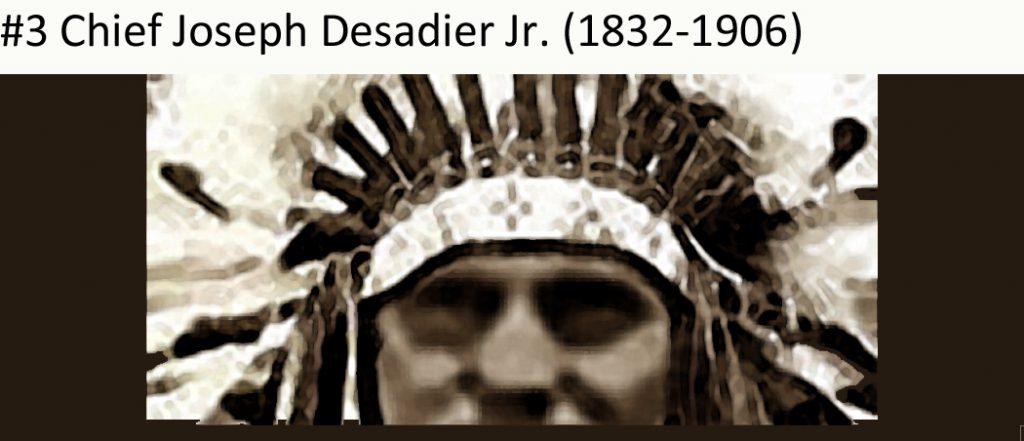
Chief Joseph Desadier Jr., 3rd Chief of the Butte Tribe of Bayou Bourbeaux was born January 16, 1832, in Bayou Bourbeaux in Natchitoches Parish. His parents were Joseph Desadier Sr. and Ana Louise Perez both Texas Indians born at the San Fernando Missions and raised in Louisiana at Bayou Bourbeaux.
Of all the Butte chiefs, Joseph Jr.’s, life span covered the historical beginnings of Louisiana and Texas within the United States. Less than a year and a half before his birth, President Andrew Jackson signed the Indian Removal Act which was in the process of being enforced on Joseph’s birthdate. This process was the force that led the pathway for future decisions made by his father in the struggle for the survival for his people. The decision was an easy one for the survival of the tribe. The tribe would adopt the ways of the white man. They would live as a family not a tribe.
STORIES OF INDIAN REMOVAL, WAR, RECONSTRUCTION AT BAYOU BOURBEAUX
As a child, Joseph would sit through meetings with the elders and here of atrocities dealt to their indigenous brothers and sisters to the East as they were forced to leave their homeland and belongings with the clothes on their backs in the dead of winter for a desolate land in the West. Thousands were dying. Some were escaping the forced journey to hide in the swamp lands of Bayou Bourbeaux.
By the age of 14, the United States had waged war on Mexico and annexed Texas Territory as a state. Mexico signed an agreement on the Rio Grande and Texas borderline. This was all good news for the Butte Tribe considering their trade in horses and cattle across the Texas line.
One day, out of nowhere, federal troops rode into Bayou Bourbeaux. They rounded up a large part of the community in one location. At that point, eight children were taken from the group. The people were told that the children were going to be placed in a school far away and when their schooling was over that they would be returned. The action caused instant rebellious activity within the community. Joseph Jr., as the family leader, was furious! He was taken in chains to the military jail where he remained for four months. The children were never returned.
At the age of 30 approximately one year after the beginning of the Civil War, President Lincoln signed the 1862 Homestead Act. After the war, abolitionists were out for everything that they could steal from all people of color, even Native Americans. Even before that time, Europeans had started moving into the bayou and marking off land as their own. Confusion was around every corner where the land was the topic. What belonged to the family had to be protected. The family had to band together to keep as much of their land as possible. The family had their ways. What was meant by that was that the only way into the Bayou Bourbeaux community was by the family’s consent. Should a person not be wanted nor welcomed in the area, the bayou would be shutdown. What was understood and realized by Joseph Jr. was that there was no one to fight or care for the indigenous people of America. The family would have to see to itself.

MARRIAGES OF JOSEPH DESADIER JR.
Joseph Jr.’s first wife was Maria Casimira Carmona whose parents and grandparents where from the Nacogdoches and Los Adaes Post in Texas. Maria Casimira was a Texas Indian by bloodline. Carmona died with no issue.
Marriage number two is the marriage that created the Butte bloodline of the family. Seraphine Josephine Ann LaRenaudiere was born June 5, 1837, to Charles Phillippe Larenaudiere and Marie Desneiges Denis. According to Chief Rodger Collum, she was the most beautiful of all of the chief’s wives. Known as Josephine, her bloodline was linked to both Texas and Chitimacha Indians of Louisiana. She was the 2nd great-granddaughter of Marie Theresa De La Grande Terre. Marie Theresa is a documented Chitimacha captive of St. Denis after his French forces raided the Chitimacha village in Mobile in retaliation of the murder of a mission French priest. Marie Theresa married French officer Jacques Guedon and settled in Bayou Bourbeaux area where many of their descendants remain today. Twelve children were produced from this marriage. One became the next chief of the Butte Tribe.
Following Josephine’s death, Joseph Jr. married Lorenza Sauce. Sauce did have a Laffite ancestor and it is possible that she had Native American ancestors. This marriage produced two children.

Last but not least at the age of 70, Joseph Jr.’s fourth wife was Delzina Gallien. She was several years younger than he at the time of their marriage. They had two sons. One was the son known as “Goose.” Goose was an interesting character in the tribe’s history. Born in the early 1900’s, he never married and never wore shoes. During his lifetime, Goose had the title of Keeper of the Mound. The mound referenced Butte Hill which is actually one of the largest mounds in the Natchitoches Parish area. Until recently revealed, few people knew anything about Butte Hill much less the fact that it was a mound. Each morning, Goose would get up, head out for Butte Hill, spend the day and come home in the afternoon.
FAMILY
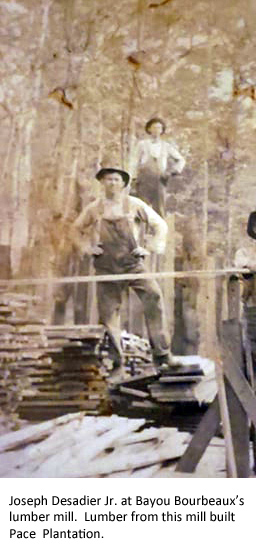
Joseph Jr. and his wife, Josephine, were very well-to-do people. They lived in a two-story house on Bayou Bourbeaux. She owned a two-story house on Texas Street in Natchitoches with a large lot. Together they owned most of Bayou Bourbeaux. Additionally, they owned land on Red River at Grande Ecore.
Family was Joseph’s main concern. He employed most of his family. Thus, he was responsible for the livelihood of all his families. The main source of income was cotton, cattle and tobacco. Crops would be planted on the lands other than the prairie lands. Cattle were free range long-horns brought in by Butte Indians from Texas and were grazed on the prairie lands. By this time most of the buffalo had been killed out by the white men that had moved into the area.
Tribal meetings and get togethers were in private. No matter the era, the government was always against the actions of Native Americans. Survival depended on secrecy. Survival depended on denial of one’s ethnicity. Everything was judged by skin color. To be black skinned was bad enough; but, according to the United States government, a red skinned man had no chance of owning land or casting a vote. A red skinned man now was an invader in his own homeland.
One of Joseph’s greatest interest was his horses. Known for his beautiful paint walking-horses, buyers came from surrounding parishes and states just to take a look at his stock. Recently, Chief Collum was checking the bloodline of one of his mares bought years ago around Lake Charles to breed with his stud horse, Rock. When looking at her papers, whose name should he see? None other than his ancestor, Joseph Desadier Jr. Yes, Joseph Jr.’s line had come home.
SCHOOL
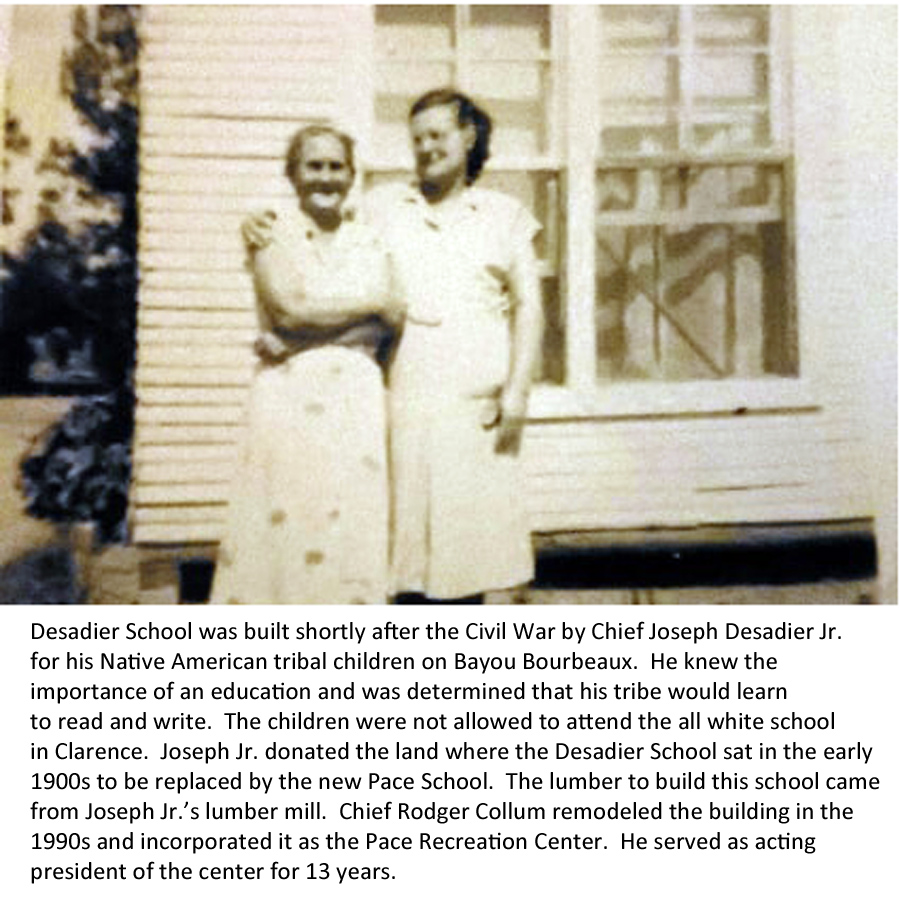
To read, write, and cipher were understood to be a basic part of life for the children of Joseph Jr. He knew the importance of knowing how to calculate and having knowledge of documents that require signatures. People of color were not allowed in the white schools of the area. Besides that fact, Joseph did not trust the children of his tribe in a white school. He would never forget the federal troops riding off with those eight children who never returned. He did not want his children away from the bayou. Therefore, he built the Desadier School in the 1870s which was the first school building in the Bayou Bourbeaux area.
BUTTE TRIBE & THE NIGHT RIDERS
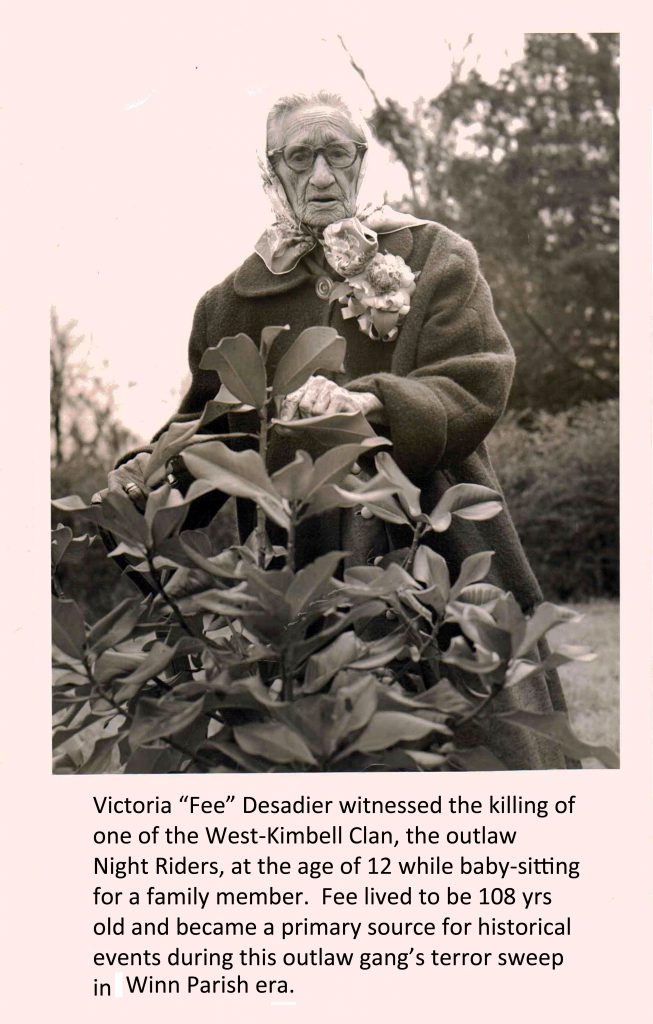
The following oral history was given to Chief Rodger Collum by his great-grandmother, Victoria “Fee” Flores Desadier (1855-1961) who was 12 years old when the first killing took place, lived during these times and personally knew the people involved in all these events. She was also the wife of Chief Adolph Felix Desadier and daughter-in-law of Chief Joseph Desadier Jr of the Butte Indians. She died at the age of 108 years old. Fee witnessed the actual killing of one of the outlaws by federal troops. She is credited as being the historical visual story-teller of the West-Kimbell Clan, The Night Riders. The story as it relates to the Butte Tribe goes like this:
Following the Civil War between 1866-1870, the Night Riders aka the West-Kimbell Clan were a local outlaw group from St. Maurice, Louisiana who ruthlessly murdered over 150 settlers traveling to the Texas territory. All the surrounding communities with the exception of Bayou Bourbeaux’s Butte community had been hit with their vicious, unmerciful slaughter of innocent people.
Operations for this malicious outlaw group was structured like a well-oiled machine. It all centered around fast-moving horses. As mentioned, Joseph Jr. had the best stock of horses in the area. The Night Riders were well aware of that fact. The issue was that the horses were on Butte land and no one wanted to mess with that tribe of people.
The plan was to first approach Joseph Jr. and bid on his fastest horses with no intention of actually paying for the horses. When the offer was made and refused, a plan was put into place to raid the herd of horses at night and take what they wanted. What the Night Riders were not prepared for was what was waiting for them when they arrived on Butte land.
Joseph Jr. understood the pattern of the murderous West-Kimbell clan. Joseph Jr. shut-down the bayou. Groups of family members waited in ambush at every entrance to Butte land. When the Night Riders came up the narrow trails in the dead of night, the Butte braves swarmed them like a hive of bees. That was the last visit of the Night Riders to Butte lands until stories of a hidden treasurer began to spread across the bayou.
One a sunny day in 1870, Victoria Fee Flores (future wife of Chief Adolf Felix Desadier) was baby-sitting for a neighbor who was related to the West-Kimbell clan. Fee was sitting on a log outside watching the children play when she saw horses riding up to the log cabin. The group riding in were lawmen looking for the Night Riders. A lady came out from the house to speak to the lawmen. When asked where the men were, she told the lawmen that no one was at that location. One of the children was nearby, heard the question and yelled out, “Yes, he is. He’s in the field.” Then, the child pointed in the direction of the field that she was speaking about. The lawmen circled the field and killed the man on the spot.
In 1872 the little community of Atlanta, Louisiana, formed a vigilante group to get rid of the Night Riders. Meantime, trading post owner-bookkeeper and treasurer of the Night Riders evil gains, Williams, got wind of what was going on in Atlanta. He called his slave, Pad, to come quickly. Together they boxed up all the treasure and headed out to hide everything until the time was safe for his return. Williams must have given previous thought of a location for hiding the loot; because when he left the trading post, he headed up the old Indian Trail and did not stop until they got to Chivery Dam. There, they followed a trail of marked trees in his loaded wagon until they came to an old duck blind and that it where they stored their loot. Williams and Pad headed out toward New Orleans until all the confusion settled down. About a year or so later, Williams returned, recovered his treasure, moved across the Red River to Natchitoches and bought up most of the available property there.
Next: Chief Joseph Pereda Desadier – 2nd Chief of Butte Tribe of Bayou Bourbeaux
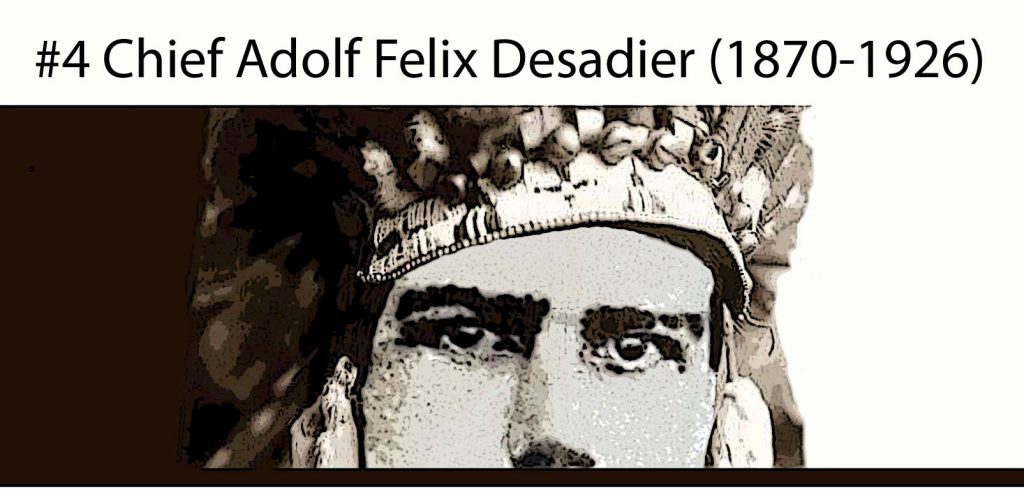
Written by: Belinda Brooks
Oral History by: Rodger Collum
Adolf “Felix” Desadier was the seventh child (third son) of Joseph and Seraphine “Josephine” Ann LaRenaudiere Desadier. He was born on December 5, 1870, in Natchitoches, Louisiana. Felix grew up under the tutorship of his father Joseph Desadier Jr (1832-1906). Joseph grew up during the years of the Indian Removal Act of 1830 and remembered well the injustices that were poured upon his people. Therefore, Felix’s generation was born a short time after the Civil War ended in 1864. For the Butte Indians during this era, President Lincoln’s views on Native Americans left them with little hope of human rights, much less citizens’ rights within the United States. In a speech delivered in 1859 at the Illinois College in Jacksonville, Lincoln stated that the United States “owns a large part of the world, by right of possessing it; and all the rest by right of wanting it, and intending to have it.”
TRIBE CHANGED TO FAMILY
Without a doubt this was the main topic of discussion when it came to the survival of the tribe. The views of the United States government had not changed when it came to the indigenous people of America. Therefore, the decision was clear where the Butte Tribe must stand on the topic of survival. They would become the Butte “Family” of Bayou Bourbeaux rather than the Butte Tribe by order of Chief Joseph Desadier Jr. In other words, the family must assimilate to the ways of the United States government or risk losing everything that had been passed down to the family from their ancestors.

PRAIRIE LANDS & INDIAN TRAILS
Felix Desadier was the last Butte Chief to live his life on the prairie lands of Bayou Bourbeaux area in Natchitoches Parish. For those who are not knowledgeable concerning the history of the prairie grasslands in the Bayou Bourbeaux area, it will be surprising for them to learn that the lakes of the area are actually man-made. Before the 1930s, the land was a vast prairie. For hundreds, maybe thousands, of years through the beginnings of the 1830s and the Indian Removal Act, thousands of buffalo roamed those prairie grasslands. Not only that but also, Bayou Bourbeau, specifically Chivery Dam, was the vertex where all the Indian Trails met at the Collum Temple Mounds. The land itself tells the tale.
Right off of the prairie grassland near Bayou Bourbeaux, known today as Prairie Lake, Native Americans physically hauled tons and tons of white sand from the hills about three miles away to make sandhills for the buffalo to roll in. These sand dunes were called “The Licks.” Buffalo were constantly trying to brush off flies, bugs, ticks and other parasites. When this happened, the Indians were sitting in wait to kill the buffalo as the buffalo were in an unsuspicious state of defense. Today, hundreds of years after the prairie lands have been covered with water in what is now known as Prairie Lake in Natchitoches Parish, one can get a still glimpse the remains of “The Lick’s” white sand and find arrowheads that were used in attempts to kill buffalo that wallowed in sand when waters of the lake are low.
Another feature of Butte territory that marked the importance of its people were the Indian trails that led to what is known today as the Collum Temple Mound. Three trails led out from the temple mound which sat on a creek which is today Chivery Dam. These three trails led to Winn Parish, Campti and Goldonna (Salt Licks). Native Americans marked the trails with bent trees which are still visible today. Butte Hill was/is located on the Indian trails. The only other waterways were Seline and Black Bayou. It made sense that the trails would lead to the temple mound because the Butte territory was a hot-spot for indigenous travel across Americas. As visiting natives would approach a Butte native village, they would first go to the temple mound, pray and leave their gift, then visit the village. The evidence of numerous Native American villages and mounds all-encompassed the Butte area.
Along with the Licks, Butte Hill and the Indian Trials, another feature of Bayou Bourbeaux was Jewel Springs. Jewel Springs was/is considered a mystic, healing springs. All of the Butte chiefs used the spring for healing purposes. They would often take their family there to picnic and spend a family day. Should someone become deathly ill or accidently hurt, they would go to the springs to wash in the healing waters. Chief Collum reports that he makes trips to the spring when the weather and the land is approachable.
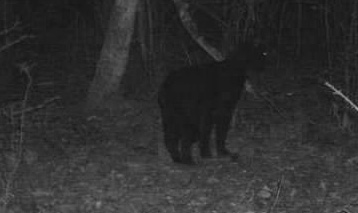
HUNTER, TRACKER, GUIDE
It was no secret that Felix was an avid hunter, tracker, and guide. He loved nature and animals. Felix was known for having beautiful horses. too. He rode a giant16.5 hands white horse. Rodger was told a story by his elders about Felix at twelve years old. For several weeks Felix and his father had been finding dead calves scattered around the farm land. There was obviously a rogue-cat on the loose thrill-killing helpless animals. Normal big-cat kills would consist of making a kill, eating whatever the cat wanted of the kill, dragging what was left over to a safe place, covering the left-overs with grass or other such objects, and returning to eat the remains at another time until it was all consumed. This cat killed calves, ate what he wanted and left the remains to the buzzards. Felix’s tracking skills were excellent. By now, Felix knew the cat was obviously a rouge-panther. With his father’s permission, he headed out on the trails with full intentions of returning home with the pelt of the offending cat. He tracked the cat for three days and nights. On the late morning of the third day, he found the cat laid up in a den of branches, straw and grass. One good shot and the cat was history.

MARRIAGE
As Felix grew to be a young man, he met and married Theresa Thompson. Not much is known about Theresa, but they had one child. His second wife and life-long companion was Victorine “Fee” Flores. Fee was 15 years older than Felix and the widow of William Carter. Her marriage with Carter produced seven children. As Native American stories and fact go, Felix Desadier was Fee’s second cousin. Felix and Fee’s mother, Elizabeth Larenaudier were first cousins. So, as a norm in Native American culture, this marriage was a familial relationship that lasted until Felix’s death in 1926. Fee never remarried and died at the age of 108 in 1961.

FAMILY LEADER
Felix was a wealthy man. He came into some money from San Antonio. Although it is not exactly known where his wealth came from, it is highly likely that he may have been involved in illegal cattle trade activities but this has not been proven. Felix and Fee lived a life of servitude to their family and their community throughout their marriage. They knew and understood too well what being tagged “Indian” meant in the United States. Family came first with them. Obviously, their skin tone was not white. Family children were not allowed in the “white” schools. Knowing that would be an issue with the segregated school systems, Felix’s father, Joseph Jr., had prepared for that when Felix was a child. Joseph had built the first school for the family children on the bayou, the Desadier School. During Joseph’s childhood, eight children were taken from the tribe to be taught the American ways and never seen again. They would always remember the children that never returned. The family would always be careful, be prepared, be watching.
Felix attended the old school that his father, Joseph Jr. built. By the time that Felix had become a man in 1905 and had his own family, the first schoolhouse was dilapidated Having a school that the family children could attend without having to be shipped off to another area was important to everyone, especially Felix. Not trusting the government with the care of the family children, Felix helped rebuild a new school near the old Desidere schoolhouse stood and where the present-day Pace Community Center stands.
Each morning before going to school, Felix’s children would milk the cows and do chores. In the summertime, all the children had to work in the fields and take care of the cattle, mules, hogs, and chickens. All of the grandchildren knew how to milk cows. The family was allowed to go to his barns and milk the cows whenever they needed to. Neighbors were also allowed to milk the cows when they were in need.
Everyday tribal life continued in the family regardless of whether one called the group a family or a tribe. Felix had the responsibility of feeding a large number of family units. The way that the family units ran in Bayou Bourbeaux is that everyone from children around 5/6 years of age up to the age of people who could work would do their part to put food on the table, clothes on the backs of the family, roofs over the heads and a bed to sleep on for everyone.

Felix was known as a specialized farmer in his era. After the Civil War in the South, slave labor was no longer allowed so farmer had to improvise. Cotton was still king in the South and fighting Johnson-grass in cotton fields was a major concern. As a child Felix raised geese that would follow him around the yard and pluck Johnson-grass right out from under his feet. That memory gave him and idea! He raised a flock of geese, drove them to the cotton fields, watched them pluck the Johnson-grass out of the cotton field at no cost and no-labor to the farmer, herded them back to the crib and locked them in for the night to protect them from coyotes or other predators. As Felix got older, he raised a little over two-hundred geese to help with his cotton.
Felix’s farm was also known for his fine-peach wine. He had a huge orchard that he took much pride in. His farmlands grew vegetables, grains and cotton which gave the family food and work.
Each month the entire bayou tribe/family would gather to travel to Natchitoches to sell seasonal farm products (grains, cotton, vegetables, wine, Spring-water, salt, etc.) and buy whatever supplies they might need, especially ammunition. In those days, the family would all have to ride the ferry across the river to Grand Ecore. One of the important products that the Butte family would sell was water from Jewel Springs close to Butte Hill. Jewel Springs was known as a healing springs in those days and people would pay for bottles of water that came from there. A few members who know the location of the springs still travel to the springs today to wash or drink from it.
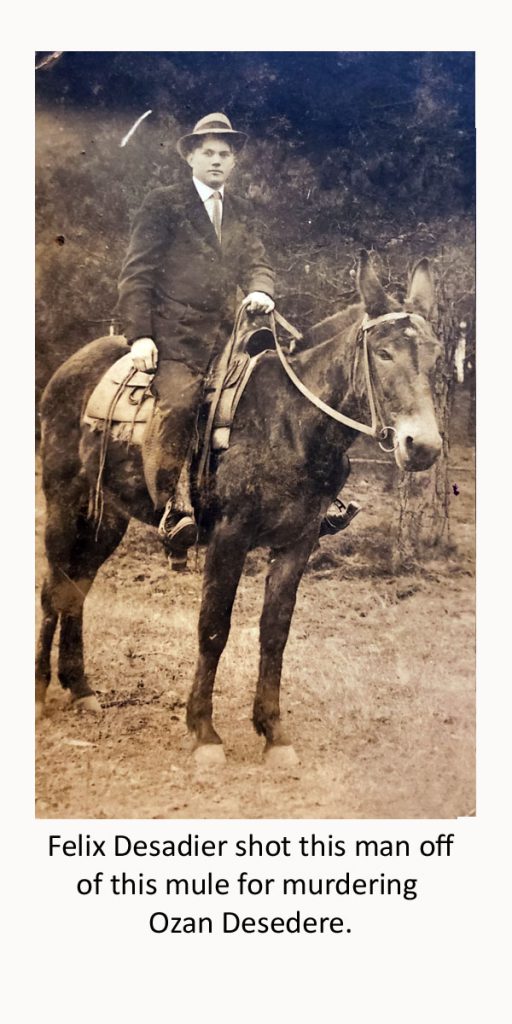
MURDER ON THE BAYOU
Years before July 5, 1905, Ozan Desadiere had left the Butte side of the bayou and moved to the Campti area when he married a Trichell cousin. On that night in 1905, Ozan was sitting at home with his family when he heard someone calling from outside. He walked to the front door and saw three men riding horses yelling out for help in the darkness. They needed him to bring a light outside to help them. Ozan hurried and did as he was asked. As soon as he stepped out on the porch with the light, he was shot dead by the men on horses.
As would be expected, word traveled fast on the bayou. Felix knew the men would be headed for Grand Ecore on the trail to escape to Texas. These men had been hanging around the area trying to buy up land for a while. He saddled his horse and headed up the trail to Grand Ecore where he waited in ambush for the murders. Sure enough, in attempt to get to Texas one of the three assailants road up the trail on a mule. Felix shot him off of the mule with buckshot but did not kill him. The man got away on foot. Felix took the mule home and kept him. The other two men were caught and taken to jail. Three weeks later, Felix got word that the man he shot made it to San Antonio and died of his wounds.
CHURCH
All Butte chiefs raised their children on the same land. Felix and Fee were no different. Their homeland is located in what is known today as the Pace Community. Bayou Bourbeaux runs straight through it. In the beginning of the 1900s, the family held church service on their land under a little brush arbor. That little brush arbor advanced to a family community brick church building named Christian Harmony Baptist Church in Natchitoches, Louisiana. The land that the church and parsonage sit on today was donated by Felix, Fee and Clarence Desadier. Throughout the years, numerous additions and upkeeps have been added to by the current chief, Rodger Collum and his wife, Charlia, as well as other family members. *Note: The Pace bloodline mixed with the Butte bloodline through, Josephine Desadier, Felix Desadier’s youngest daughter.
DEATH OF A GREAT CHIEF
Felix was a working man. It was not enough for him to give orders for others to do a job. He always had to be a part of the jobs that were going on. One of his favorite things to do was to work in his orchards and make wine. One day he fell from a pear tree. That fall led to a punctured spleen and a long and painful death. Felix was bed-ridden for a long time during his illness. He was carried by sled to Jewel Springs several times and washed in the healing waters in hopes of a cure.
Chief Adolf Felix Desadier was cut short at the age of 56 on December 26, 1926. He left his son, Chief Clarence Desadier, to carry on and lead the family.
Next, Chief Joseph Desadier Jr, 3rd Chief of Butte Tribe of Bayou Bourbeaux
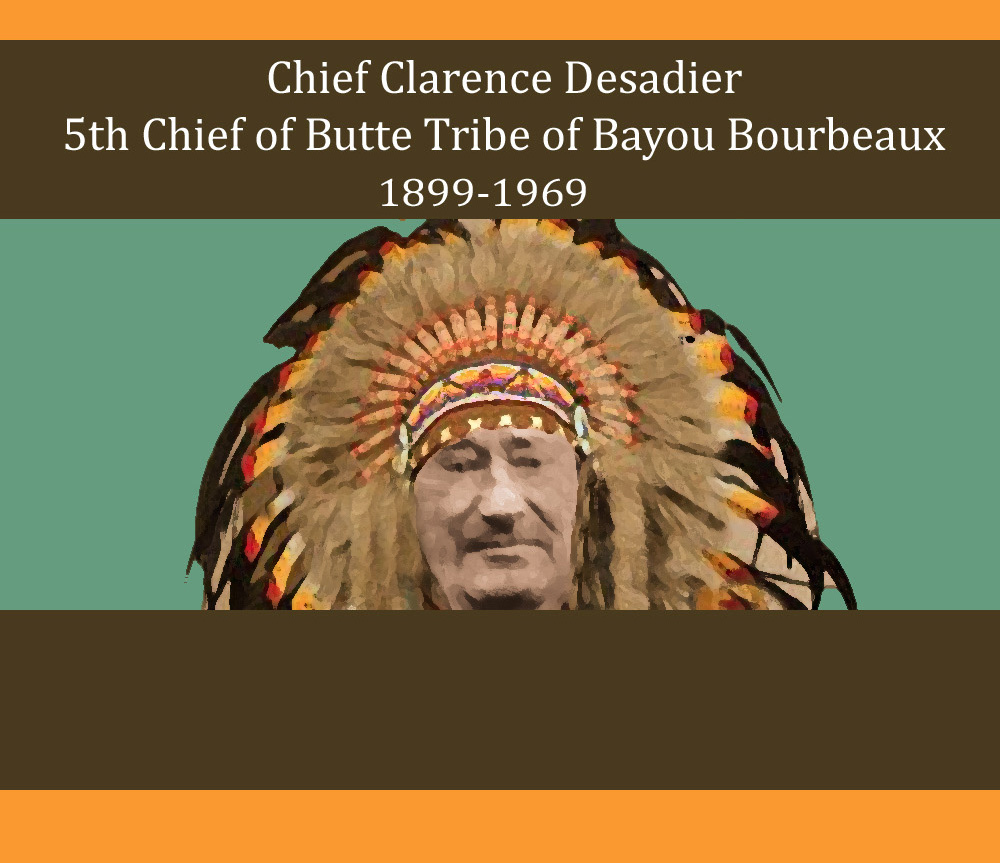
Chief#5- Clarence Desadier (1899-1969)
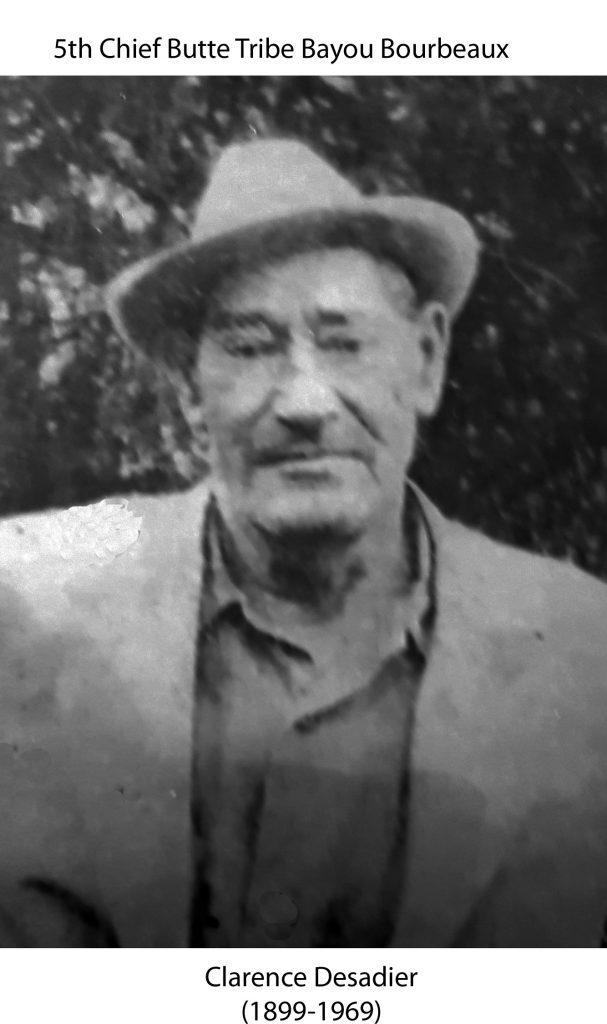
Clarence Desadier was the second son of Felix and Victorine “Fee” Flores Desadier. Although he was the second son, he was chosen by his parents for the position of the fifth family leader/chief of the Butte Tribe. He was chosen for this position because of his obvious love of family, work ethics and his ability of keeping the family together. As a businessman, his skills in managing money and real estate were outstanding. His parents could depend on him to do whatever it took to see that the family did not go lacking in food, shelter and education. Not only did he care for his family, his love for his entire bayou community was evident by the way he shared what he had with others.
In true Native American cultural, familial lifestyle, Clarence Desadier found his wife and life partner within his tribe. On November 17, 1917, Clarence married Louella Waters, his second cousin. Clarence and Louella’s grandmothers were sisters, Seraphine Josephine and Marie Zelina Larenaudiere. The Larenaudiere sisters were the second-great granddaughters of Marie Theresa De La Grande Terre, the Chitimacha wife of Frenchman Jacques (dit Nantes) Guedon. Together, Clarence and Louella raised three sons and four daughters on the same land that the present-day chief, Rodger Collum, resides.
Clarence’s service to the family began in the early 1920s when his father’s health began to decline. Following Felix Desadier’s death in 1926, Clarence became the head of the family with his mother, Fee, standing at his side. Concerned about his people, Clarence aka “Parrain” to the family, made sure that his truck garden was planted and his milk cows were well cared for and ready to produce milk for the family as well as those in the community who were living in hard times.
Undoubtedly, the late 1920s and 1930s were hard times for those raising families in and around Bayou Bourbeaux as well as the entire United States. 1927 brought the historic Mississippi River flood. The flood waters in Louisiana displaced many of the Butte Tribe families who had relocated their families closer to the Mississippi River in hopes of making a better life for their families. October 1929 marked the month of the Wallstreet Crash and the onset of the Great Depression. Then, shortly after the economy finally began to recover in 1939, World War II began and the young men within the family received draft cards that stripped them away from their families to serve their country on foreign shores. Clarence had two sons, Otis and Henry, who served during WWII. During these hard times, Clarence made sure that those in his family who remained on Butte land had jobs to go to, food on the table, beds to sleep in and roofs over their heads.
Through it all, Clarence was careful to keep the family bloodline under-the-radar. Why? His grandfather, Joseph Desadier Jr., lived through the 1830s Indian Removal Act. Joseph knew only too well the discrimination, hatred and disrespect that the United States government held for the indigenous people of America. Joseph made the decision during those times that the “tribe” would become a “family.” No longer would the Butte Tribe acknowledge their Native American bloodlines. White settlers were determined to claim the rich, alluvial lands of the Native Americans. While on behalf of the settlers and their own interest, the government with no concern for Native Americans forcibly removed indigenous people from their ancestral homes to ghost lands of the West with no resemblance to the land of their forefathers. To keep Butte lands and families in place, it was necessary to take on a new cultural identity.
Clarence’s mother, Fee, lived to be 108 years old. At her death, all of her assets were left to Clarence to distribute. Fee trusted her son to do what was right with her belongings. His decision on distribution of her property was based on work ethics of his siblings. Clarence carried on the expected duties of the family leader and continued to oversee family business meetings and reunions. He kept the family tightly knitted by working together, growing crops together, burying their dead together, and so forth. He was a well-respected leader who held many titles. He was the local game warden, a deputy sheriff, a preacher, as well as a farmer and cattle man.
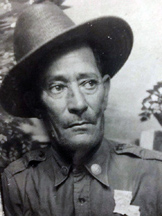
Clarence’s main concern as a game warden was outsiders hunting on Butte lands and killing wildlife need to support the welfare of his people. This concern was what actually led him to become a game warden. Times were very hard and the family depended on wildlife such as deer, hogs, rabbits, squirrels, ducks, geese and other game to survive. As an official federal wildlife game warden, he was responsible for the preservation of wildlife on Bayou Bourbeaux, which in turn allowed for the survival of this family. To illustrate this point by comparing/contrasting hunting rabbits on the bayou in Clarence’s lifetime compared to hunting rabbits on the bayou in today’s world, taking a ride down the backroads of the bayou at night time to see how many rabbits can be spotlighted would tell the tale. During the lifetime of Clarence, it was easy to spotlight hundreds if not thousands of rabbits running across dirt roads and fields at night. In contrast, today, one can ride for miles and miles up and down bayou roads and not see one rabbit on the side of or crossing the road.
Spirituality/religion has always been a significant factor in the lives of the Butte families. For Clarence, this was certainly true. Throughout his lifetime, he along with his parents, played key roles in the building of the Christian Harmony Baptist Church in the Pace Community. The land that the church and parsonage sit on today was donated by Felix, Fee and Clarence Desadier. History of that little church began in the early 1900s with both Felix and Clarence as well as many other family members having served as deacons throughout its lifespan. Hundreds of family members were born (christened), baptized and buried into that church. The church recently celebrated its 130th birthday celebration.
Saturdays and Sundays were always times for family gatherings. Grandma Fee, Clarence’s mother, always lived within walking distance of her son’s home. Her children were raised to understand the importance of family togetherness. Saturdays were visiting days. Family from near and far would travel to sit around the yard under trees and on the porch to watch children play, drink coffee or sweet tea, enjoy fresh baked tea-cakes, talk about current events and relate oral family history. Saturday gatherings were no less than 20 to 30 family members passing by. When the evening came, someone would likely break out a fiddle and it was time for music and dance.
Sundays were always spent in church, no exception. Everyone would bring pot-luck dishes and there was always more than enough food to share with all who attended. At times, upward of 100 people would come to “Paw” Clarence and “Maw” Louella’s house to eat. The norm would be 50-60 people after church for lunch. Family came from all directions. There was a pecking order to seating at meals. Elders were seated and served first followed by the rest of the family. Teaching children to respect their elders was and continues to be a major responsibility passed on by adults of the Butte Tribe.
Comically, Chief Collum likes to remind his people how special he was to the elders, or at least to his mom, Olla Mae, and Maw Louella. On Sunday just for him, they always made his favorite banana pudding (without bananas.) Knowing that Rodger had to wait in line with the children, Olla Mae and Louella had a special place set aside for him where there was always a bowl of pudding waiting just for him.
Each month, Clarence would call a meeting of family elders. These meetings were rather traditional in their schedule. About 20 elders would be in attendance. Clarence always opened the meeting with prayer. Coffee, tea, Kool-Aid, and teacakes were served. After taking time to greet everyone, the group would then sing old family, tribal songs. Money would be collected for family needs. There may have been family that were sick or short on cash to pay bills and the money collected would go to help with those issues. Storytellers would tell stories about life when they were children. They would relate to Rodger the traditions and customs of their lifetime. The elders would talk about the importance of hunting and fishing on Bayou Bourbeaux. Many within the tribe were hunting and fishing guides in Natchitoches Parish which was a popular tourist site for hunters through the state. Without the plentiful supply of wildlife, the family would have never made it through the hard times of the Great Depression in the 1930s. For Clarence and the elders, controlling and protecting Butte lands depended on keeping outsiders away from their land.
Fond, humorous memories of Clarence and Louella Desadier told by their grandchildren are numerous. Clarence’s children all lived in the surrounding area. Each evening, Louella and he would take a ride around to check on his daughters and their families before they went to bed. All the family knew that Maw Louella liked her beer, especially when she went riding. This created an issue for Paw Clarence since he was a preacher man. Rodger and his cousin, Buddy Hayes, laugh when they tell the story about riding with their grandparents at those times. Clarence would drive up to the local “beer” stop and park in the dark. Someone from inside would walk outside with a brown paper bag with Maw Louella’s favorite drink inside. Clarence would pay for it and they would be on their way.

Rodger always speaks of Maw Louella with a smile on his face. He would go to her first, whenever he wanted something that he felt his Paw or parents would deny him. Maw was always up to the challenge of making deals with him. He and his cousin-in-crime, Buddy Hayes, loved to go hunting beginning when they were only five and six years of age. Others may have objected but with Maw on their sides they pretty much knew, without a doubt, it was a done-deal. They had guns but ammo was hard to come by. Maw Louella always liked to cook rabbit. Maw would get the boys shells if they would hunt rabbits and bring her some back for supper. Now, you might think what was the big deal about getting shells? The big deal was that Paw Clarence was a Wildlife and Fisheries Agent. The boys were too young to hunt on their own and would have to go hunting behind their grandfather’s back. Paw confronted Louella. Louella in her slow, southern drawl would respond, “Now, Clar…ence, you know you enjoy eatin’ them rabbits.” That was it! No more was said about the boys hunting or Louella passing out the shells. Louella always had the say-so when it came to the pots and pans.
Buddy told the story that on a cold winter day Maw decided that she was going to cook geese for the family. The boys were around the ages of eight and nine at the time. She gave Rodger and Buddy a box of shells with the initial “HV” on them. What were they to do? If Maw said do it, they had no choice. So, they eagerly headed out with the dogs to the bayou waters to find the biggest, bad’est, fattest goose to deck Maw’s Sunday table. Suddenly, Buddy spied a gigantic goose that seemed hundreds of yards away. He pointed it out to Rodger and said, “We’re too far away for you to hit it.” Rodger said, “No, man! Give me one of those HIGH VOLTAGE shells Maw got us.” Buddy gave him the shell and, sure enough, that goose was as good as cooked. Rodger killed it on the spot. Buddy said, “Wow, Rodger! Never heard of those HIGH VOLTAGE shells. Maw needs to get us a bunch of them.”

On a more serious note, there were times that Clarence, as head of the family, had to shut the bayou down. Friday, December 6, 1957, Kenneth Wayne Frederick, Clarence’s grandson, left Clarence’s house with two dogs to go rabbit hunting. When the dogs returned without the grandson, Clarence called in the family, shut down the bayou and the hunt was on. The Town Talk newspaper of Alexandria, Louisiana, reported that, “It was the grandfather who traced the boy’s footprints from near the Pikes home for about 2,000 feet until they faded out into the swamp.” Bayou Bourbeaux was shut down for approximately two weeks. No one could enter or leave the bayou unless they were family or part of the search party until the body of Clarence’s grandson was found. The body was found partially submerged in the bayou under a Bayou Bourbeaux bridge near the Clarence community on December 18th, 1957. The coroner later ruled that the cause of death was drowning.
Years before that accident, another Bayou Bourbeaux crisis occurred when a tornado came through the bayou. A midwife who lived on the bayou was standing in her front yard holding her baby. The baby was not old enough to sit up by itself at the time. Suddenly, a big wind sucked the baby from the mother’s arms. The mother was in a panic running from one place to another to try to find her baby. She could not find her anywhere. Knowing that when people had problems on the bayou that Clarence was the person to contact, she immediately got in touch with him. Clarence formed a search party right away. For two days the community searched for that baby. On the second day, someone heard a strange sound coming from the field behind the Christian Harmony Baptist Church. It sounded like a small animal that was in trouble. Sure enough, it was the baby. He was alive and well. There are many more stories like these to tell. Much more than time will allow. Through good times or bad, Clarence never failed his people. His wisdom and love for his people were passed down to his chosen successor, Chief Rodger Collum.
Clarence and Louella lived their lives during the beginnings of the Industrial Revolution in the United States. For them, they enjoyed all of the new modernized inventions. It would be accurate to say that in the Bayou Bourbeaux area they enjoyed the first of all that the new inventions that technology had to offer. They were first to have a phone, a tractor, as well as a car with an air conditioner and automatic transmission. They were also the first to purchase a television.
The passing of Clarence and Louella Desadier was mourned by many of the Bayou Bourbeaux community. At the time of Clarence’s passing in 1969, Louella stood by the side of her grandson, Rodger Collum, until he came of age to take on the responsibility of leading the family/tribe for the next generations. Louella passed that baton to Rodger at the birth of his first child and son, Shannon, in 1975.
Next article, 4th Chief of the Butte Tribe of Bayou Bourbeaux, Adolph Felix Desadier.
by: Belinda Brooks
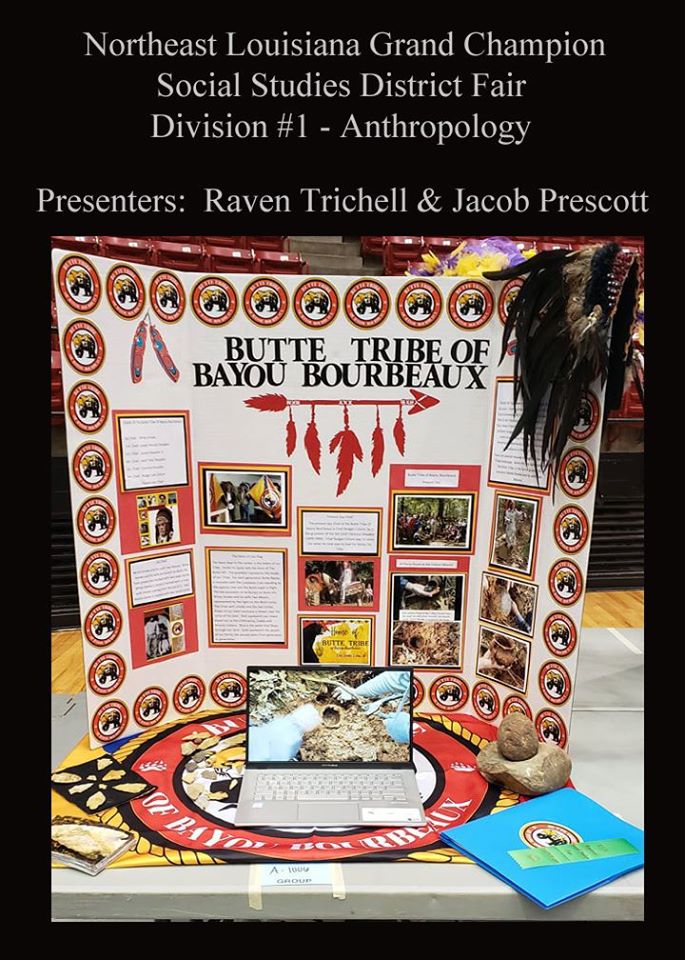

Butte Tribe’s own Ravin Trichell & her partner, Jacob Prescott, took top-honors in the 2020 Social Studies Fair Presentations at ULM Euwing Coliseum in Monroe, Louisiana, today. Their presentation on the Butte Tribe of Bayou Bourbeaux was awarded Grand Champsonship Honors of the entire event for Division 1 Schools. They will be moving to State Competition in May 2020. Congratualations, Ravin & Jacob! You have made your tribe very proud of you. Good Luck in State Competition!!!! Thank you for inviting me to be a part of the big day. bb
